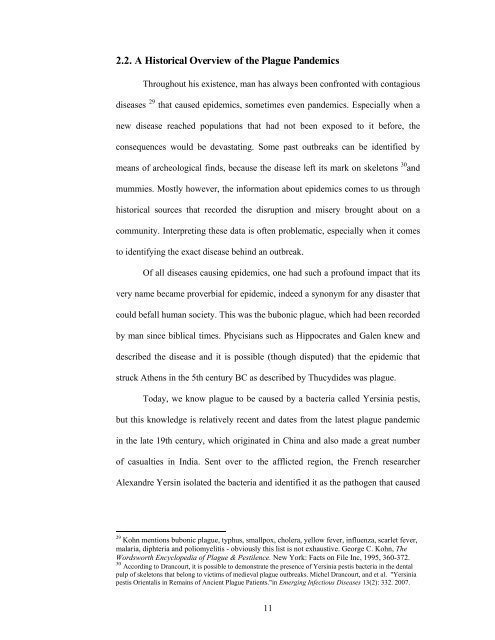the black death in early ottoman territories - Bilkent University
the black death in early ottoman territories - Bilkent University
the black death in early ottoman territories - Bilkent University
You also want an ePaper? Increase the reach of your titles
YUMPU automatically turns print PDFs into web optimized ePapers that Google loves.
2.2. A Historical Overview of <strong>the</strong> Plague Pandemics<br />
Throughout his existence, man has always been confronted with contagious<br />
diseases 29 that caused epidemics, sometimes even pandemics. Especially when a<br />
new disease reached populations that had not been exposed to it before, <strong>the</strong><br />
consequences would be devastat<strong>in</strong>g. Some past outbreaks can be identified by<br />
means of archeological f<strong>in</strong>ds, because <strong>the</strong> disease left its mark on skeletons 30 and<br />
mummies. Mostly however, <strong>the</strong> <strong>in</strong>formation about epidemics comes to us through<br />
historical sources that recorded <strong>the</strong> disruption and misery brought about on a<br />
community. Interpret<strong>in</strong>g <strong>the</strong>se data is often problematic, especially when it comes<br />
to identify<strong>in</strong>g <strong>the</strong> exact disease beh<strong>in</strong>d an outbreak.<br />
Of all diseases caus<strong>in</strong>g epidemics, one had such a profound impact that its<br />
very name became proverbial for epidemic, <strong>in</strong>deed a synonym for any disaster that<br />
could befall human society. This was <strong>the</strong> bubonic plague, which had been recorded<br />
by man s<strong>in</strong>ce biblical times. Phycisians such as Hippocrates and Galen knew and<br />
described <strong>the</strong> disease and it is possible (though disputed) that <strong>the</strong> epidemic that<br />
struck A<strong>the</strong>ns <strong>in</strong> <strong>the</strong> 5th century BC as described by Thucydides was plague.<br />
Today, we know plague to be caused by a bacteria called Yers<strong>in</strong>ia pestis,<br />
but this knowledge is relatively recent and dates from <strong>the</strong> latest plague pandemic<br />
<strong>in</strong> <strong>the</strong> late 19th century, which orig<strong>in</strong>ated <strong>in</strong> Ch<strong>in</strong>a and also made a great number<br />
of casualties <strong>in</strong> India. Sent over to <strong>the</strong> afflicted region, <strong>the</strong> French researcher<br />
Alexandre Yers<strong>in</strong> isolated <strong>the</strong> bacteria and identified it as <strong>the</strong> pathogen that caused<br />
29 Kohn mentions bubonic plague, typhus, smallpox, cholera, yellow fever, <strong>in</strong>fluenza, scarlet fever,<br />
malaria, diphteria and poliomyelitis - obviously this list is not exhaustive. George C. Kohn, The<br />
Wordsworth Encyclopedia of Plague & Pestilence. New York: Facts on File Inc, 1995, 360-372.<br />
30 Accord<strong>in</strong>g to Drancourt, it is possible to demonstrate <strong>the</strong> presence of Yers<strong>in</strong>ia pestis bacteria <strong>in</strong> <strong>the</strong> dental<br />
pulp of skeletons that belong to victims of medieval plague outbreaks. Michel Drancourt, and et al. "Yers<strong>in</strong>ia<br />
pestis Orientalis <strong>in</strong> Rema<strong>in</strong>s of Ancient Plague Patients."<strong>in</strong> Emerg<strong>in</strong>g Infectious Diseases 13(2): 332. 2007.<br />
11
















